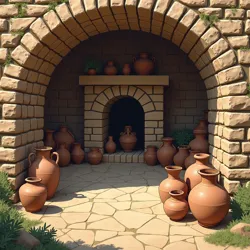Etruscan Ceremonial Pottery
 An elaborately decorated ceremonial vessel from the Volterra region, displaying characteristic religious motifs and sophisticated glazing techniques
An elaborately decorated ceremonial vessel from the Volterra region, displaying characteristic religious motifs and sophisticated glazing techniquesEtruscan ceremonial pottery represents a significant category of archaeological artifacts that provides crucial insights into the religious practices, artistic achievements, and social structures of pre-Roman Italy. These vessels, produced between the 8th and 3rd centuries BC, demonstrate the remarkable technical sophistication and cultural complexity of Etruscan civilization, particularly in their use for religious rituals, funerary practices, and elite social ceremonies.
Historical Development
The emergence of specialized ceremonial pottery in Etruscan society coincided with the development of complex religious institutions and social hierarchies during the Orientalizing period (750-600 BC). Early examples show strong influences from Eastern Mediterranean artistic traditions, particularly in their use of mythological imagery and decorative patterns. The craft reached its zenith during the 6th century BC, as exemplified by masterworks like the renowned Boar Vessel discovered in Velathri.
Etruscan potters developed increasingly sophisticated techniques throughout the Archaic period, establishing distinct regional styles and specialized workshops. The Northern Etruscan school became particularly renowned for its production of ceremonial vessels, developing innovative methods for creating complex forms and applying detailed surface decorations. This period saw the establishment of major production centers in Chiusi and the Volterra region, each developing characteristic local variations in style and technique.
Manufacturing Techniques
 Reconstruction of an Etruscan pottery kiln based on archaeological evidence from the Tyrrhenian Coast
Reconstruction of an Etruscan pottery kiln based on archaeological evidence from the Tyrrhenian CoastThe creation of ceremonial pottery involved highly specialized techniques passed down through generations of master craftsmen. Potters employed sophisticated clay preparation methods that included careful selection of raw materials, extensive levigation, and the addition of specific tempering agents to achieve desired properties. The most prestigious vessels were crafted using the finest mineral-based slip compositions, often incorporating rare pigments and metallic oxides to create distinctive surface effects.
The manufacturing process typically began with the careful preparation of specially selected clays, often sourced from specific deposits known for their superior qualities. Master potters utilized both hand-building techniques and early forms of the potter's wheel to create complex vessel shapes. The application of surface decorations involved multiple stages, including the use of specialized tools for incising designs, applying relief elements, and creating textured patterns.
Ritual Functions
Ceremonial vessels served diverse religious and social functions in Etruscan society. Many were specifically designed for use in Underworld Festivals and other religious ceremonies, where they played crucial roles in libation rituals and offerings to deities. The vessels often incorporated symbolic elements associated with specific cults, such as the Cult of Selvans, and frequently featured imagery related to Etruscan cosmological beliefs.
The use of these vessels extended beyond purely religious contexts into the realm of social prestige and political power. Elite families commissioned increasingly elaborate pieces for use in ceremonial banquets and as grave goods, leading to the development of new forms and decorative styles. The practice of including ceremonial pottery in tomb assemblages has provided archaeologists with valuable information about Etruscan burial customs and social hierarchies.
Typology and Classification
Scholars have identified several distinct categories of ceremonial vessels, each associated with specific ritual functions and social contexts. Large kraters and amphoras were typically used for mixing and serving wine during religious ceremonies and elite banquets. Specialized forms like the Tyrrhenian zoomorphic vessels often served specific ritual purposes, while smaller vessels such as libation bowls and incense burners were designed for particular ceremonial actions.
The classification of these vessels has been refined through careful study of their physical characteristics, decoration, and archaeological contexts. Modern archaeometric dating techniques have helped establish precise chronologies for different styles and manufacturing techniques, while chemical analysis of residues has provided valuable information about their actual use in ancient times.
Cultural Exchange and Influence
Etruscan ceremonial pottery both influenced and was influenced by contemporary Mediterranean cultures. Through the Mediterranean trading network, Etruscan potters encountered Greek, Phoenician, and Egyptian ceramic traditions, selectively adapting foreign elements while maintaining distinctive local characteristics. The exchange of techniques and artistic motifs created a rich dialogue between different cultural traditions, contributing to the development of new styles and forms.
Modern Study and Conservation
Contemporary research into Etruscan ceremonial pottery employs a range of advanced analytical techniques. The Institute of Pre-Roman Studies has pioneered new methods for studying manufacturing techniques and usage patterns, while conservation specialists have developed innovative approaches to preserving these delicate artifacts. Major collections, such as those housed in the Museum of Ancient Tyrrhenia, continue to provide new insights into Etruscan ceramic traditions.
See also
- Pre-Roman Italian artisans
- Ancient Mediterranean Trade Routes
- Etruscan Religious Practices
References
Research findings from the Journal of Mediterranean Archaeology and various archaeological reports have contributed significantly to our understanding of Etruscan ceremonial pottery. Additional insights have been gained through the ongoing work of the Special Exhibition of Etruscan Ritual Objects and related research initiatives.